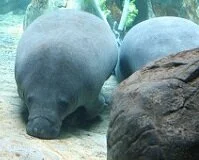Wildlife

Manatee
Belize's location between North America and South America, along with its weather makes the country incredibly diverse, despite its small size. Although some large mammals do exist, such as the jaguar and puma (cougar), most of the country's land mammals are rather small. Among these other mammals are the ocelot, otter, tapir, anteater, armadillo, deer, and monkeys. The largest mammals are off Belize's coast where whales, manatees, and dolphins swim. Also in the Caribbean Sea there are thousands of salt water fish and shellfish, including sharks, rays, eels, barracuda, jellyfish, and hundreds of other fish. Off the coast is also the world's second largest barrier reef, which is home to hundreds of rare and endangered species.
Staying in the waters, the amphibians and reptiles in Belize are impressive, including having numerous turtles, frogs, iguanas, snakes, and crocodiles. The country hosts numerous water fowls as well, such as the stork, osprey, and heron. Further inland, one can find toucans, macaws, turkeys, and owls. Due to the waters and marshes, there is no shortage of insects in Belize.